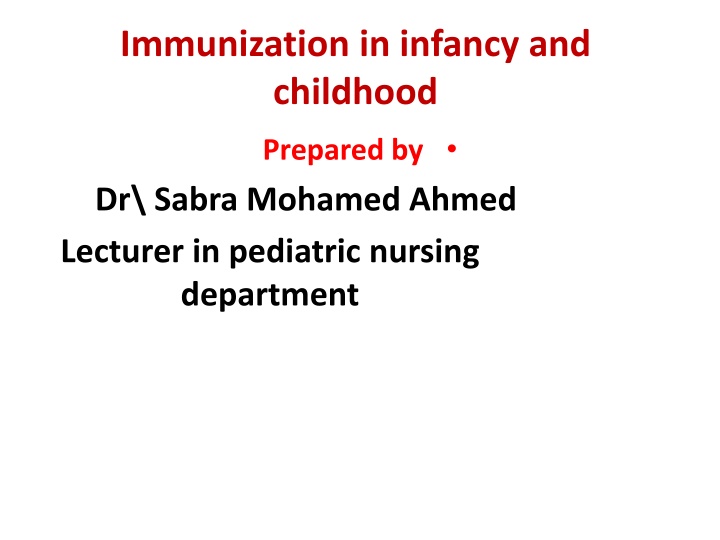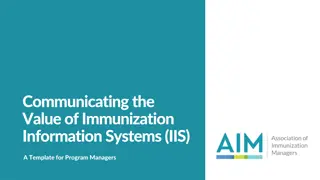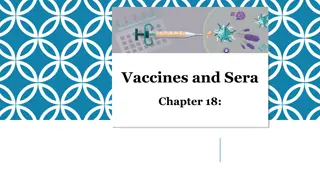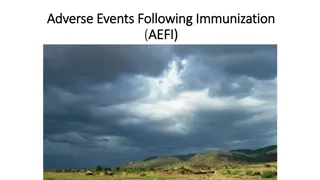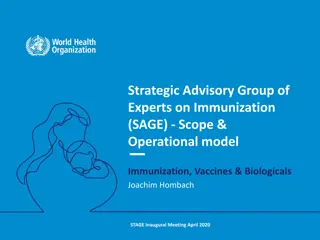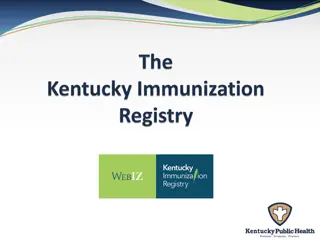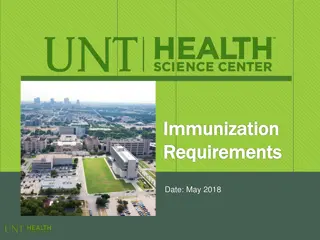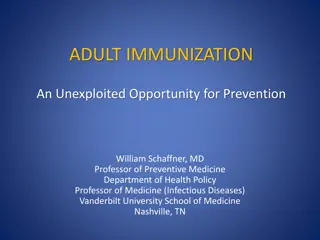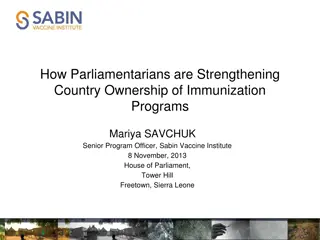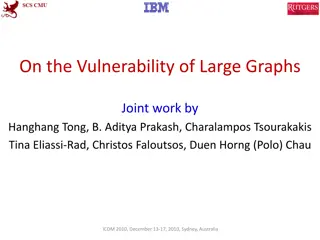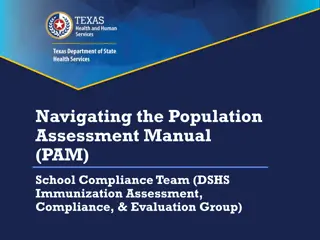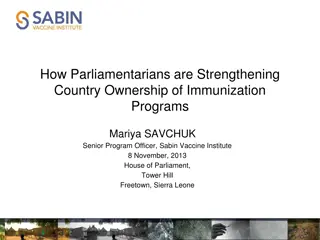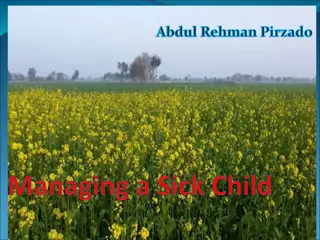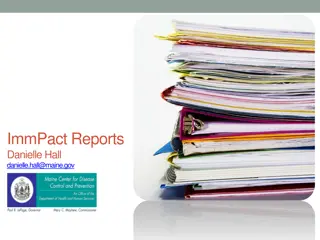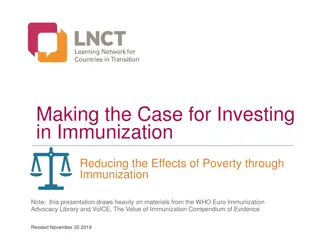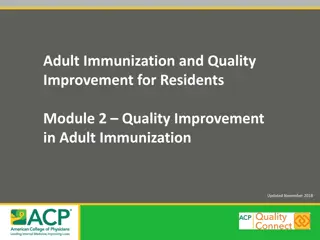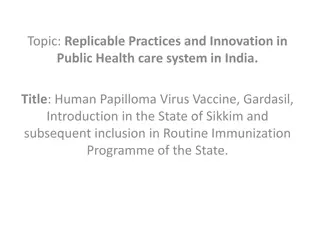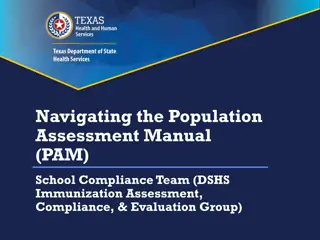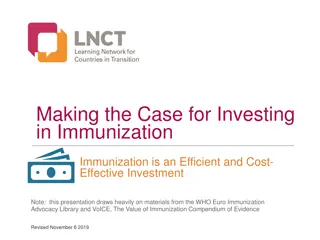Immunization in Infancy & Childhood: Understanding the Importance
Immunization in infancy and childhood is vital to building immunity against infectious diseases. Learn about different types of immunity, diseases prevented by vaccines, and various kinds of vaccines available, including live attenuated, killed, and toxoid vaccines.
Download Presentation

Please find below an Image/Link to download the presentation.
The content on the website is provided AS IS for your information and personal use only. It may not be sold, licensed, or shared on other websites without obtaining consent from the author.If you encounter any issues during the download, it is possible that the publisher has removed the file from their server.
You are allowed to download the files provided on this website for personal or commercial use, subject to the condition that they are used lawfully. All files are the property of their respective owners.
The content on the website is provided AS IS for your information and personal use only. It may not be sold, licensed, or shared on other websites without obtaining consent from the author.
E N D
Presentation Transcript
Immunization in infancy and childhood Prepared by Dr\ Sabra Mohamed Ahmed Lecturer in pediatric nursing department
Definition It is the process through which the body acquires specific immunity towards a specific agent. it can be either passive ( trans placental, milk or therapeutic or active ( diseases or vaccination) Other definition:-Immunization (vaccination) is a way of creating immunity to certain diseases by using small amounts of a microorganism that causes the particular disease. killed or weakened
Aim of immunization to build up resistance in the child against certain infectious disease
Different kinds of immunity 1.Inherent 2.Acquired A-Natural:- 1-Passive (Maternal) e.g. measles, diphtheria, polio 2-Active (infection) e.g. measles, German measles, chicken pox, diphtheria, polio, mumps B-Artificial:- 1-Passive e.g. measles diphtheria, polio, tetanus, viral hepatitis 2-Active measles, German measles, small pox, diphtheria, polio, mumps, pertussis.
Diseases which are prevented by vaccines 1. Tuberculosis (TB). 2. Diphtheria. 3. Tetanus. 4. Measles. 5. Poliomyelitis. 6. Pertussis. 7. Viral hepatitis.
Definition of vaccine: Vaccines are weapons to prevent diseases. This may be made of microorganisms similar to the ones that cause diseases, or of the toxins produced by the disease but changed so that they cannot harm people
Types of vaccines: Live vaccines:(vaccines containing live attenuated microorganisms). A-BCG vaccine: against TB B-Polio vaccine: against poliomyelitis c -Measles vaccine 2-Killed vaccine: (vaccines not containing live microorganisms they contain Killed microorganisms:- A-Pertussis vaccine (whooping cough) b -Salk vaccine: against poliomyelitis c -Hepatitis B vaccine 3 -Vaccines containing the toxins:- That the bacteria produce after changing:- Them into harmless toxoid: A-Diphtheria toxoid B-Tetanus toxoid
Vaccine storage in the health centers 1-The correct temperature to keep vaccine is between 0C and 8C . 2-Polio and measles vaccines are kept on the top shelf of the refrigerator under the Freezer 3-The rest of the vaccines, DPT, DT, TT, BCG and Hepatitis B are kept on the Second shelf of the refrigerator. 4-Freezing does not damage live attenuated vaccines (BCG, Polio and Measles vaccines). These vaccines can be frozen in central, govern orate or district stores in deep freezers. 5-Freezing damages the killed vaccines and toxoids (DPT, DT and TT).
Cold Chain System The cold chain system is a system for distributing vaccine in a potent state from the manufacturer to the actual vaccination site. Health center and the cold chain The principle responsibilities of managing the cold chain system in the health center are to: -A obtain vaccines: 1- Estimate the right amount of vaccine. 2-Make sure you have enough cold chain equipment to store the vaccine you will collect. 3- Check the types and amount of vaccine. 4- Check the expiry date of vaccine. 5- Use the shortest route to transport the vaccine. 6- Keep the vaccine containers in the shade. 7- After reaching the health center, transfer vaccines properly and quickly to the refrigerator.
B Maintain equipment: 1. Refrigerator. 2. Cold box. 3. Vaccine carriers 4. Ice packs.
Things that damage vaccines 1-All vaccines lose their potency after a certain time even with good are. 2-Heat and sunlight can damage vaccines, especially the live attenuated ones (polio-measles and BCG). 3-Freezing damages the killed vaccines and toxoids (DPT, DT, TT and Hepatitis B). 4-Disinfectants or antiseptics vaccines and antibiotics such as streptomycin on B can damage
Obligatory vaccination in Egypt: Schedule of Obligatory Vaccinations
Nature of vaccine Age Vaccine Rout Dose Oral, on the dorsum of tongue 2-3drops Sabin Live attenuated polio virus 2 month Polio IM inj. at anterior 0.5 ml D=Diphtheria toxoid. P=Pertussis DPT -lateral aspect of Lt thigh. killed bacteria. T=Tetanus toxoid. Hepatitis Hepatitis-B - IM inj at anterior -lateral aspect of Rt thigh. 0.5 ml Hepatitis B surface Antigen manufactured
Intra-dermal inj. at upper Lt Live 4 month. BCG 0.1 ml attenuated bovine TB bacillus arm. Dose II of Polio, DTP, & Hepatitis-B. Same as at 2 months age Dose II of Polio, DTP, & Hepatitis-B. Same as at 2 months age 6 month. MMR SC. at Rt arm. Live attenuated measles 12 month 0.5 ml virus. A 4thdose. Polio
MMR -Polio -DTP 1.5 years Booster dose I 4-6 years - Polio -DTP Booster dose II Notes: vitamin A ; first dose 100,000 I.U oral, at age 9 months vitamin A; second dose 200,000 I.U oral, at age 18 months
Necessary vaccination in Egypt: Schedule of necessary Vaccinations in Egypt At 2 month, 4 month, 6 month influenza virus (0.5 ml) IM injection At 12 month small box (0.5 ml) SC At 18 month influenza virus At 24 month Hepatitis-A (0.5 ml) IM, Meningitis (0.5 ml) SC At 30 month Hepatitis-A (0.5 ml) IM 4-6 years BCG, MMR, Meningitis
Other Vaccines given for specific diseases 1-Meningococal polysaccharide vaccine 2-Hepatitis A vaccine 3-Typhoid-Paratyphoid vaccine 4-Influenza virus vaccine 5-Cholera vaccine
Side effects of vaccinations 1-Side effects of BCG: A-Normal reaction: BCG bacteria grow very slowly. After two weeks, a small red soft tender swelling about 10 mm across appears at the place of the injection of BCG. Then after 2 3 weeks more, the swelling becomes a small abscess, which then because an ulcer about 10 mm across. The ulcer heals by it self The mothers should be advised not to put any medicine on the ulcer. They should leave it uncovered or if necessary cover it with dry gauze only. B Severe reaction: Sometimes there is a severe local inflammation or a deeper abscess, sometimes the lymphatic glands near the elbow or the axilla swell this may be because the injection of the vaccine was subcutaneous, or because the child was given a large dose or the needle used was not sterile. C -Early reaction: If the child already has some immunity to TB, the red swelling may appear earlier than two weeks. This means that the child has already had BCG or that he has had a TB infection
2-Side effects of DPT vaccine [Diphtheria, pertussis and Tetanus]: A Fever: Many children have fever in the evening after they have had DPT vaccine, it lasts one day. A fever that begins more than 24 hours after a dose of DPT is not due to the vaccine, so check for another infection you must:- Pain and fever may be treated with acetaminophen or ibuprofen. Advise the child mother not to wrap the child up in many clothes. B-Local soreness: Some children have pain, soreness, redness or swelling in the leg where they had the injection. If this starts early, the day after the injection, then it is due to the vaccine. You must:- A warm, damp cloth or a heating pad at the injection site also may help minimize soreness C-Abscess:-If pain and swelling begin a week or more after injection, it may be due to an abscess formation, this can happen in the following condition: -If the syringe is not sterile. -If you touch the needle with your finger -If you put the syringe down on an un sterile place.
D-Convulsions: -Very rarely the child has convulsions. Convulsions are due to the pertussis part of the vaccine, is common in children over 6 months of age. If the child has convulsions or shock in the following three days, do not give the child any other doses of DPT it is better to complete the doses with DT.
3 -Side effects of measles vaccine: -Fever and rash children may have a fever for 1-3 days about one week after giving the vaccine, sometimes there is a rash like a mild measles rash. The mother should be advised to:- give acetaminophen or ibuprofen.
Contra indications to child immunization Very severely ill children who need to be hospitalized or children who have very high fever, should delay vaccination. If a child has had severe reactions from DPT injection (convulsion or shock) don t give that child any more doses of DPT, give him DT Vaccine. BCG is the only vaccine, which should not be administered to children with clinically apparent Aids or immune deficiency disease
